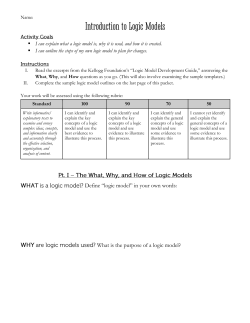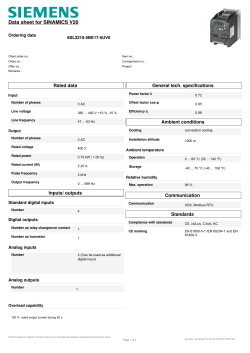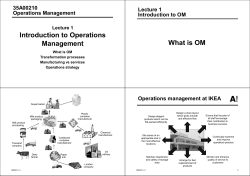
Κατ’ όικον Εργασία 4 1.
ΗΜΥ 210 – Σχεδιασμός Ψηφιακών Συστημάτων Χειμερινό Εξάμηνο 2013 Κατ’ όικον Εργασία 4 1. A simple well-know game, tic-tac-toe, is played on a 3x3 grid of squares by two players. The players alternate turns. Each player chooses a square and places a mark in a square. (One player uses X and the other O.) The first player with 3 marks in a row, or in a column, or on a diagonal wins the game. A logic circuit is to be designed for an electronic tic-tac-toe that indicates the presence of a winning pattern. The circuit output W is a 1 if a winning pattern is present and a 0 if a winning pattern is not present. For each of the nine squares, there are two signals, Xi and Oi. Two copies of the circuit are used, one for Xi’s and one for Oi’s. Hint: Form a condensed truth table for W(X1,X2,…,X9). (a) Design the X circuit for the following pattern of signals for the squares: X1 X2 X3 X4 X5 X6 X7 X8 X9 (b) Minimize the W output for the X circuit as much as possible, using Boolean Algebra. 2. Design a combinational circuit that accepts a 3-bit number and generates a 6-bit binary number output equal to the square of the input number. 3. Suppose you are asked to design a new component, a decimal decoder that is optimized for applications in which only decimal input combinations are expected to occur. How can the cost of such a decoder be minimized compared to one that is simply a 4-to-16 decoder with six outputs removed? Write the logic equations for all 10 outputs of the minimized decoder, assuming active-high inputs and outputs and no enable signals. 4. Twenty years ago, a famous logic designer decided to quit teaching and make a fortune by licensing the circuit shown below. a) Label the inputs and outputs of the circuit with appropriate signal names, including active-level indications. b) What does the circuit do? Be specific and account for all inputs and outputs. 5. Design a 4-to-16 decoder with enable using five 2-to-4 decoders with enable signals. 1 ΗΜΥ 210 – Σχεδιασμός Ψηφιακών Συστημάτων Χειμερινό Εξάμηνο 2013 6. Design a 10-to-4 encoder with inputs in the 1-out-of-10 code and outputs in a code like normal BCD, except that input lines 8 and 9 are encoded as “E” and “F”, respectively. 7. Derive the truth table of a decimal-to-binary priority encoder. There are 10 inputs I1 through I9 and outputs A3 through A0 and V. Input I9 has the highest priority. 8. Design a customized multiplexer with five 4-bit input buses A, B, C, D, and E, selecting only one of the buses to drive the 4-bit output bus T, according to the table below. You can use any type of gate and type of standard (of any size) single multiplexer. S2 0 0 0 0 1 1 1 1 9. S1 0 0 1 1 0 0 1 1 S0 0 1 0 1 0 1 0 1 Input to Select (T= …) A (=A0A1A2A3) B (=B0B1B2B3) A (=A0A1A2A3) C (=C0C1C2C3) A (=A0A1A2A3) D (=D0D1D2D3) A (=A0A1A2A3) E (=E0E1E2E3) Implement the following Boolean function with a 4-to-1 multiplexer and external gates. Connect inputs A and B to the selection lines. The input requirements for the four data lines will be a function of the variables C and D. The values of these variables are obtained by expressing F as a function of C and D for each of the four cases when AB = 00, 01, 10, and 11. These functions must be implemented with external gates. F(A,B,C,D) = ∑m(1, 3, 4, 11, 12, 13, 14, 15) 10. 2 Repeat problem 8 using two 3-to-8 decoders with enables, an inverter, and OR gates with a maximum fan-in of 4.
© Copyright 2025





















